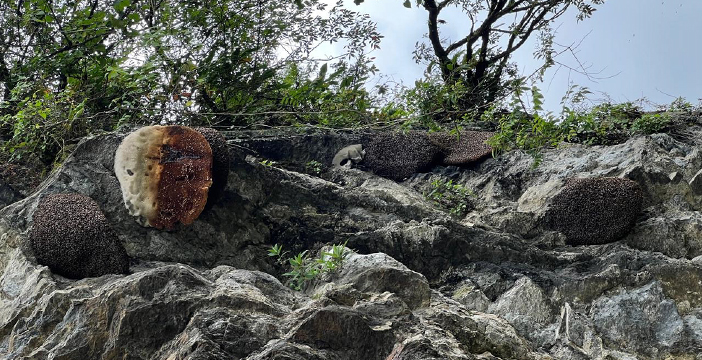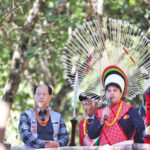
For many years, Nagas have been harvesting rock bees. The image above pictures a rock bee hive from Chendang village, Tuensang, which is scheduled to be harvested in September during a full moon night. It is believed that harvesting on a full moon night yields a richer honey harvest.
Chongshen, the Associate Director of the Eleutheros Christian Society (ECS) in Tuensang, commended the long-standing tradition of rock bee harvesting, which extends to about 4-5 villages in Tuensang, including Chendang, Konya and Kejok which are all in Changsang range of Tuensang district. The rock bees are also found in Bhumpak village which is in Sanyochung range; however, it is said that the Bhumpak villagers traditionally do not harvest the honey much.
He clarified that while rock bees are wild, some rock cliffs are owned by clans, others by private individuals, and still, others are community property, each categorized accordingly.
Regarding the economic benefits of these honey for farmers, Chongshen explained that organizations like ECS purchase honey directly from the farmers. He explained that farmers sell their honey to NGOs or FBOs, and any profits those organizations make after selling it go right back to the farmers.
When asked about the distribution of the honey—whether it stays within the district, the state, or is sold outside of the state—the Associate Director clarified that rock bee honey isn’t farmed in large quantities. “Rock bees aren’t cultivated; their production is entirely organic and natural. The quantity harvested isn’t substantial, around 2000-5000 liters annually. In contrast, honeybee honey is cultivated, and we yield about 10-20 tons annually. Interestingly, our local community prefers honey bee honey, while those outside the region have a preference for rock bee honey,” he told Mokokchung Times.
Differentiating between honeybee and rock bee honey, he pointed out that honeybee honey tends to be sticky, while rock bee honey has a more watery consistency. He added, “Rock bees are entirely organic since they are predominantly found in dense forests.”

Chongshen also shed light on the unique tradition and culture associated with rock bee harvesting. He shared, “Within Chendang village, there is a belief that if you claim ownership of a rock cliff, you should place an egg there to minimize bee stings. This belief, though superstitious, beautifully intertwines with our traditions and culture. It is as if, if you secretly go to get the honey, the bee stings will be more intense.”
He further mentioned that, historically, people would dress in traditional attire to “show their superiority” during the harvest. However, in recent times, people have opted for personal protective equipment (PPE) kits for convenience.
Chongshen also clarified that the rock bee stings but are not fatal like wasp stings, yet are more aggressive than those of honeybees. However, they are not life-threatening. “You could endure 100 stings and still be perfectly fine,” he humorously added.
Chongshen explained that the method of harvesting varies depending on the height of the cliffs. In places like Konya village, where cliffs are exceptionally high, harvesters might need to spend 2-3 days in the jungle to harvest the honey. Some cliffs are dangerously steep, he said, yet people venture forth without safety precautions. However, when the cliffs are not too towering, the harvesting process becomes relatively easier, he added.



